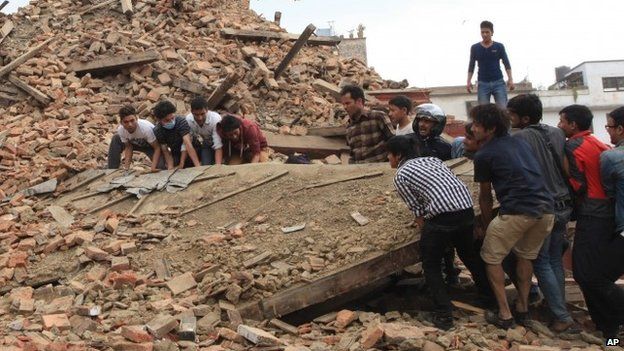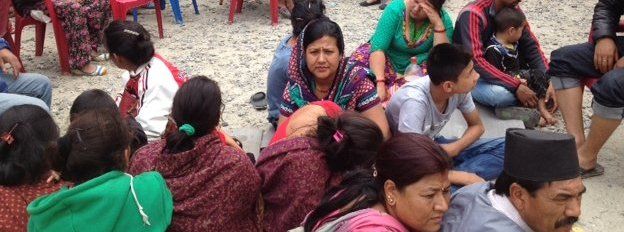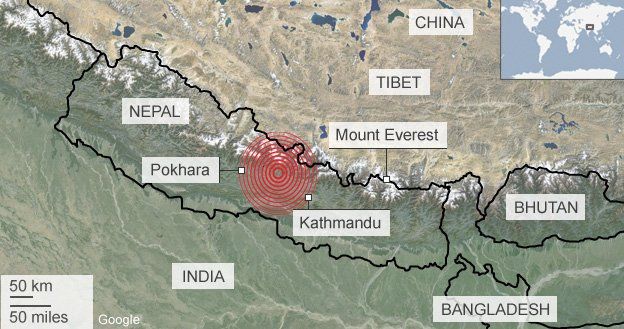 Relief efforts in Nepal are intensifying after more than 2,300 people were killed in the worst earthquake there in more than 80 years.
Relief efforts in Nepal are intensifying after more than 2,300 people were killed in the worst earthquake there in more than 80 years.
Rescue missions and aid material have started arriving in the country.
Seventeen people have been killed on Mt Everest by avalanches – the mountain’s worst-ever disaster.
Meanwhile a powerful aftershock was felt on Sunday in Nepal, India and Bangladesh, and more avalanches were reported near Everest.
The 6.7-magnitude tremor, centred 60km (40 miles) east of Nepal’s capital Kathmandu, sent people running in panic for open ground in the city.


At the scene: By Surendra Phuyal, BBC News, Kathmandu
As military helicopters hovered over Kathmandu and ferried relief supplies to victims of the earthquake in western Nepal, search and rescue efforts were going on in at least five locations in Kathmandu.
Near the prime minister’s official residence, two bulldozers scoured the rubble of a flattened four-storey house.
A bystander said it was the local tax office. The bodies of the four staff inside had been recovered minutes before.
As the search and road-clearing efforts got under way at noon, a major aftershock sent people into a panic again.
At a nearby open space, people were camped out fearing further tremors. They were short of food and water – clearly hoping and praying that the aftershocks would stop and things would be normal soon.

The death toll from the original earthquake on Saturday could rise, as the situation is unclear in remote areas which remain cut off or hard to access.
Many mountain roads are cracked or blocked by landslides.
Scores of bodies have been ferried to hospitals in Kathmandu, many of which are struggling to cope with the number of injured.
More than 700 have died in the capital alone.


Tents have been set up in a parade ground in the city centre to house thousands of people displaced by the earthquake.
Medics are expecting a fresh influx of patients on Sunday as supplies run low.
Rescuers used their bare hands in places to dig for survivors still buried underneath piles of rubble and debris overnight on Saturday.
Army officer Santosh Nepal told the Reuters news agency that he and his soldiers had to dig a passage into a collapsed three-storey residential building in Kathmandu using pickaxes because bulldozers could not get through the ancient city’s narrow streets.
“We believe there are still people trapped inside,” he told Reuters.
The 7.8-magnitude quake struck an area of central Nepal between Kathmandu and the city of Pokhara on Saturday morning.
There were also victims in India, Bangladesh and in the Chinese region of Tibet.
It is the worst earthquake in Nepal since 1934, when some 8,500 people were killed.

Analysis – BBC Science correspondent Jonathan Amos
Large quakes are generally followed by a flurry of aftershocks, which tend to reduce in strength and frequency as time goes on.
As a rule of thumb, seismologists might expect to see at least one aftershock that measures roughly a magnitude less than the main shock. One of these, with a Magnitude of 6.6, was seen just half an hour after Saturday’s main 7.8 event. Sunday has now experienced a further big aftershock of 6.7. From the early data, the tremor looks to have originated closer to the surface than Saturday’s big shakers.
Although each step down on the magnitude scale is a 30-times drop in the energy released, Sunday’s big aftershock will not have felt like that for those on the ground. And, of course, it may have toppled many already severely damaged buildings, adding to the difficulties of the rescue operation.































